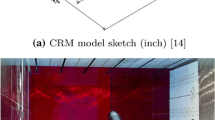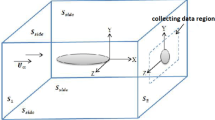Abstract
A boundary element-wake numerical approach is developed and used to determine all drag components of a three dimensional body in a wind tunnel flow. The approach decomposes the total drag into three components; the profile drag, the cross flow drag (induced drag), and the tunnel-wall effect component, each with its own physical significance. Additionally, the cross flow drag component is divided into two components, the vortex component and the source (dilatation) component. In the present approach, the transverse kinematics relations are expressed as integral representations of the axial vorticity and the transverse dilatation (source strength). This advantage permits the vortex and the source drag computations to be performed only in the vortical area of the transverse wake and hence avoids excessive computations. Also, the procedures distinguish the contribution of the transverse dilatation to the cross flow drag. The validity of the present procedure is examined by comparing the present results against the experimental data of reference [1] for a car and wing models. The comparison shows that the present computed total drag, for the wing and the car models, agrees very well with the experimental data, provided that the wake data are measured at survey planes moderately distant from the body.
Similar content being viewed by others
Abbreviations
- A :
-
cross sectional area of the tunnel
- a :
-
point on the boundary
- B :
-
boundary of the cross sectional area
- C D :
-
drag coefficient
- D :
-
drag
- H :
-
total head of the flow
- n :
-
normal direction
- p :
-
static pressure
- S :
-
model reference area
- u,v,w :
-
thex, y, andz components of the flow velocity vector
- u o :
-
undisturbed flow velocity
- u b :
-
wake blockage velocity
- u*:
-
reference velocity
- u n :
-
deviation ofu* fromu o
- x,y,z :
-
the Cartesian coordinates with thex-axis in the undisturbed tunnel flow direction. They andz axis are in the transverse plane
- ψ:
-
stream function associated with (ξ) in the transverse plane
- ø:
-
scalar potential function associated with (σ) in the transverse plane
- γ:
-
vortex sheet strength
- ξ:
-
axial components of vorticity
- σ:
-
source strength in the transverse plane
- ρ:
-
fluid density
- Δy :
-
grid size iny-direction in the transverse plane
- Δz :
-
grid size inz-direction in the transverse plane
- A :
-
tunnel cross sectional area
- b :
-
boundary of the tunnel cross section area
- c :
-
cross flow component
- cv :
-
vortex cross flow component
- cs :
-
source cross flow component
- i :
-
refer to grid node in the transverse section
- n :
-
normal unit vector on the boundary (b)
- o :
-
the undisturbed tunnel flow conditions, also describe the dummy variables of integration in the integral equations
- p :
-
profile component
- t :
-
total
- W :
-
vortical wake, also designate the wake-blockage component
- 1:
-
an upstream measurement station
- 2:
-
a downstream measurement station
References
Hackett, J.E., Phillips, C.G. and Lilley, D.E., Three-dimensional wake flow measurements for a wing and a bluff, car-like body. Lockheed Report LG 81 ER 0201, Lockheed Georgia Company (1981) Georgia 30063: Marietta.
Betz, A., Ein Verfahren zur direkten Ermittlung des Profilwiderstandes.Zeitschrift für Flugtechnik und Motorluftschiffahrt 3 (1925).
Maskell, E.C., Progress towards a method for the measurements of the components of the drag of wing of finite span, Royal Aircraft Establishment. Technical Report 72232 (1925).
Wu, J.C., Hackett, J.E. and Lilley, D.E., A generalized wake-integral approach for drag determination in three-dimensional flows. AIAA paper 79-279 (1979).
Hackett, J.E. and Sugavanam, A., Evaluation of a complete wake integral for the drag of a car-like shape. SAE paper No. 840577, February (1984).
Wu, J.C., Numerical boundary conditions for viscous flow problems.AIAA Journal 14(8) (1976) 1042–1049.
El-Refaee, M. M., Boundary layer control of separated flow over circular cylinders — A BEM parametric study.Journal of Engineering Analysis with Boundary Elements 14 (1994) 239–254.
El-Refaee, M., Wu, J.C. and Lekoudis, S., Solution of the compressible Navier-Stokes equations using the integral method.AIAA Journal 20(3) (1982) 356–362.
Author information
Authors and Affiliations
Rights and permissions
About this article
Cite this article
El-Refaee, M.M. Calculation of all drag components for 3-D bodies in wind tunnel flows. A boundary element-wake approach. Appl. Sci. Res. 55, 119–139 (1995). https://doi.org/10.1007/BF00868467
Received:
Accepted:
Issue Date:
DOI: https://doi.org/10.1007/BF00868467




